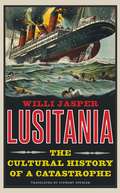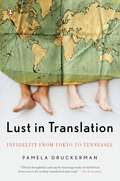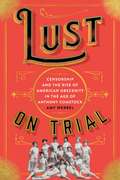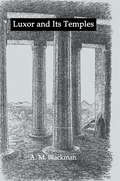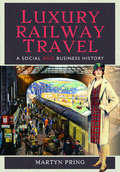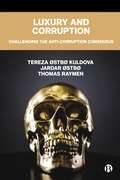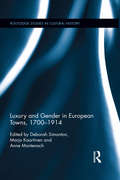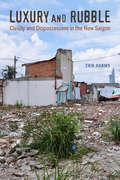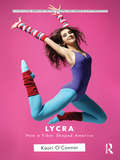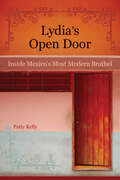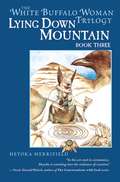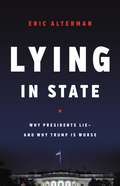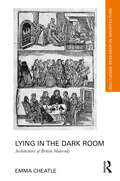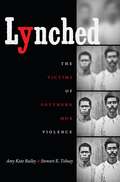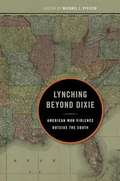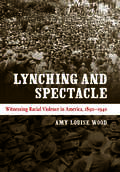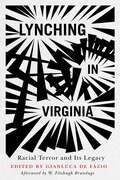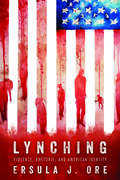- Table View
- List View
Lusitania: The Cultural History of a Catastrophe
by Willi Jasper Mr Stewart SpencerA fascinating reassessment of a turning point in the First World War, revealing its role in shaping the German psyche On May 7, 1915, the Lusitania, a large British luxury liner, was sunk by a German submarine off the Irish coast. Nearly 1,200 people, including 128 American citizens, lost their lives. The sinking of a civilian passenger vessel without warning was a scandal of international scale and helped precipitate the United States' decision to enter the conflict. It also led to the immediate vilification of Germany. Though the ship's sinking has preoccupied historians and the general public for over a century, until now the German side of the story has been largely untold. Drawing on varied German sources, historian Willi Jasper provides a comprehensive reappraisal of the sinking and its aftermath that focuses on the German reaction and psyche. The attack on the Lusitania, he argues, was not simply an escalation of violence but signaled a new ideological, moral, and religious dimension in the struggle between German Kultur and Western civilization.
Luso-Tropicalism and Its Discontents: The Making and Unmaking of Racial Exceptionalism
by Warwick Anderson Ricardo Ventura Santos Ricardo RoqueModern perceptions of race across much of the Global South are indebted to the Brazilian social scientist Gilberto Freyre, who in works such as The Masters and the Slaves claimed that Portuguese colonialism produced exceptionally benign and tolerant race relations. This volume radically reinterprets Freyre’s Luso-tropicalist arguments and critically engages with the historical complexity of racial concepts and practices in the Portuguese-speaking world. Encompassing Brazil as well as Portuguese-speaking societies in Africa, Asia, and even Portugal itself, it places an interdisciplinary group of scholars in conversation to challenge the conventional understanding of twentieth-century racialization, proffering new insights into such controversial topics as human plasticity, racial amalgamation, and the tropes and proxies of whiteness.
Lust in Translation: Infidelity from Tokyo to Tennessee
by Pamela DruckermanCompared to the citizens of just about every other nation, Americans are the least adept at having affairs, have the most trouble enjoying them, and suffer the most in their aftermath and Pamela Druckerman has the facts to prove it. The journalist's surprising findings include: Russian spouses don't count beach resort flings as infidelity South Africans consider drunkenness an adequate excuse for extramarital sex Japanese businessmen believe, "If you pay, it's not cheating."Voyeuristic and packed with eyebrow-raising statistics and interviews, Lust in Translation is her funny and fact-filled world tour of infidelity that will give new meaning to the phrase "practicing monogamy."
Lust on Trial: Censorship and the Rise of American Obscenity in the Age of Anthony Comstock
by Amy WerbelAnthony Comstock was America’s first professional censor. From 1873 to 1915, as Secretary of the New York Society for the Suppression of Vice, Comstock led a crusade against lasciviousness, salaciousness, and obscenity that resulted in the confiscation and incineration of more than three million pictures, postcards, and books he judged to be obscene. But as Amy Werbel shows in this rich cultural and social history, Comstock’s campaign to rid America of vice in fact led to greater acceptance of the materials he deemed objectionable, offering a revealing tale about the unintended consequences of censorship.In Lust on Trial, Werbel presents a colorful journey through Comstock’s career that doubles as a new history of post–Civil War America’s risqué visual and sexual culture. Born into a puritanical New England community, Anthony Comstock moved to New York in 1868 armed with his Christian faith and a burning desire to rid the city of vice. Werbel describes how Comstock’s raids shaped New York City and American culture through his obsession with the prevention of lust by means of censorship, and how his restrictions provided an impetus for the increased circulation and explicitness of “obscene” materials. By opposing women who preached sexual liberation and empowerment, suppressing contraceptives, and restricting artistic expression, Comstock drew the ire of civil liberties advocates, inspiring more open attitudes toward sexual and creative freedom and more sophisticated legal defenses. Drawing on material culture high and low, including numerous examples of the “obscenities” Comstock seized, Lust on Trial provides fresh insights into Comstock’s actions and motivations, the sexual habits of Americans during his era, and the complicated relationship between law and cultural change.
Lust und Abgrund: Theologische und kulturwissenschaftliche Zugänge zum Begehren (pop.religion: lebensstil – kultur – theologie)
by Richard Janus Harald Schroeter-WittkeDas Buch beleuchtet die Komplexe Lust, Begehren und Abgrund in popkulturellen Darstellungen aus theologischer und kulturwissenschaftlicher Perspektive.
Luttes paysannes en Colombie 1970-2016: Conflit agraire et perspectives de paix (Études en développement international et mondialisation)
by Leila CelisLa lutte pour la terre : voilà l’une des questions centrales du conflit en Colombie. Cette étude porte sur la logique et les actions des acteurs sociaux et armés dans cette lutte, et explore les conditions essentielles à la construction de la paix. Ce livre retrace l’évolution du mouvement agraire depuis les années 1970 en dégageant quatre phases ou dynamiques distinctes : autogestion, réclamation, résistance et autodétermination. Dans la première, les paysans luttent principalement pour la terre à travers la colonisation des terres publiques et l’occupation des terres de grands propriétaires. Dans la deuxième, ils se mobilisent pour revendiquer des investissements publics dans la vie et la production agricole. La troisième phase de la lutte paysanne correspond à la résistance juridique et aux déplacements intraterritoriaux devant la violence paramilitaire. Finalement, la quatrième phase correspond à la lutte actuelle contre l’extractivisme et pour l’autonomie territoriale. L’étude se base principalement sur l’histoire de l’Association nationale des paysans de la Colombie (ANUC), fondée en 1967, de la Fédération des paysans et des mineurs artisanaux du sud de Bolivar (FEDEAGROMISBOL), fondée en 1985, et de la Coordination nationale agraire (CNA), fondée en 1997. Ces organisations regroupent des paysans, petits et moyens propriétaires, dont la propriété n’est pas complètement légalisée et qui exploitent la terre dans des conditions précaires. Publié en français
Luxor And Its Temples
by A.M. BlackmanFirst published in 2005. Routledge is an imprint of Taylor & Francis, an informa company.
Luxury Railway Travel: A Social and Business History
by Martyn Pring&“Reads like an extravagant time travel through Britain&’s opulence era where train travel was just as stylish and fanciful as the elite class themselves.&” —Manhattan with a Twist Martyn Pring has carried out considerable research tracing the evolution of British luxury train travel weaving railway, social and travel history threads around a number of Britain&’s mainline routes traditionally associated with glamorous trains. Drawing on contemporary coverage, he chronicles the luxury products and services shaped by railway companies and hospitality businesses for Britain&’s burgeoning upper and middle classes and wealthy overseas visitors, particularly Americans, who demanded more civilized and comfortable rail travel. By Edwardian times, a pleasure-palace industry emerged as entrepreneurs, hotel proprietors, local authorities and railway companies all collaborated developing upscale destinations, building civic amenities, creating sightseeing and leisure pursuits and in place-making initiatives to attract prosperous patrons. Luxury named trains delivered sophisticated and fashionable settings encouraging a golden age of civilized business and leisure travel. Harkening back to the inter-war years, modern luxury train operators now redefine and capture the allure and excitement of dining and train travel experiences. &“Martyn&’s extraordinarily beautiful book is more than a collection of classic railway posters—it describes a way of life that&’s now lost in the mists of the twentieth century . . . As a piece of social history, this book is faultless, and a precious reminder of luxury and class distinction . . . [a] fabulous book. Exceptional.&” —Books Monthly &“A comprehensive account of luxury &‘hotel trains,&’ dining trains and the presentations of heritage railways brings the story to its unexpected conclusion . . . this is a lively take on a neglected topic.&” —BackTrack
Luxury and Corruption: Challenging the Anti-Corruption Consensus
by Jardar Østbø Thomas Raymen Tereza Østbø KuldovaThe world has been bombarded in recent years with images of the luxurious lives and wealth of corrupt oligarchs and kleptocrats, amassed at the expense of ordinary people. Such images exploit our feelings of injustice, are taken as indicative of moral decay, and inspire a desire to purge our economies of dirty money, objects, and people. But why do anti-corruption efforts routinely fail? What kind of world are they creating? Looking at luxury art, antiquities, superyachts, and populist politics, this book explores the connection between luxury and corruption, and offers an alternative to the received wisdom of how we tackle corruption.
Luxury and Gender in European Towns, 1700-1914 (Routledge Studies in Cultural History)
by Deborah Simonton, Marjo Kaartinen and Anne MontenachThis book conceives the role of the modern town as a crucial place for material and cultural circulations of luxury. It concentrates on a critical period of historical change, the long eighteenth and nineteenth centuries, that was marked by the passage from a society of scarcity to one of expenditure and accumulation, from ranks and orders to greater social mobility, from traditional aristocratic luxury to a new bourgeois and even democratic form of luxury. This volume recognizes the notion that luxury operated as a mechanism of social separation, but also that all classes aspired to engage in consumption at some level, thus extending the idea of what constituted luxury and blurring the boundaries of class and status, often in unsettling ways. It moves beyond the moral aspects of luxury and the luxury debates to analyze how the production, distribution, purchase or display of luxury goods could participate in the creation of autonomous selves and thus challenge gender roles.
Luxury and Rubble: Civility and Dispossession in the New Saigon
by Erik HarmsA free ebook version of this title will be available through Luminos, University of California Press's open access publishing program for monographs. Visit www.luminosoa.org to learn more.Luxury and Rubble is the tale of two cities in Ho Chi Minh City. It is the story of two planned, mixed-use residential and commercial developments that are changing the face of Vietnam's largest city. Since the early 1990s, such developments have been steadily reorganizing urban landscapes across the country. For many Vietnamese, they are a symbol of the country's emergence into global modernity and of post-socialist economic reforms. However, they are also sites of great contestation, sparking land disputes and controversies over how to compensate evicted residents. In this penetrating ethnography, Erik Harms vividly portrays the human costs of urban reorganization as he explores the complex and sometimes contradictory experiences of individuals grappling with the forces of privatization in a socialist country.
Luxury and the Ruling Elite in Socialist Hungary: Villas, Hunts, and Soccer Games (Studies in Hungarian History)
by György MajtényiAfter World War II, a new community of elite emerged in Hungary, in spite of the communist principles espoused by the government. In Luxury and the Ruling Elite in Socialist Hungary, György Majtényi allows us a peek inside their affluence.Majtényi exposes the lavish standard of living that the higher echelon enjoyed, complete with pools, Persian rugs, extravagant furniture, servants, and groundskeepers. They shopped in private stores stocked with expensive meats and tropical fruits just for them. They benefited from access to everything from books, telephone lines, and international travel to hunting grounds, soccer games, and even the choicest cemetery plots. But Majtényi also reveals the underbelly of such society, particularly how these privileges were used as a way of maintaining power, initiating or denying entry to party members, and strengthening the very hierarchies that communism promised to abolish.Taking readers on a fascinating and often surprising look inside the manor homes and vacation villas of wealthy post–World War II Hungarians, Majtényi offers fresh insight into the realities of patriarchy, loyalty, gender, and class within the communist regime.
Lycanthropy in German Literature (Palgrave Studies in Modern European Literature)
by Peter ArndsLycanthropy in German Literature argues that as a symbol of both power and parasitism, the human wolf of the Germanic Middle Ages is iconic to the representation of the persecution of undesirables in the German cultural imagination from the early modern age to the post-war literary scene.
Lycra: How A Fiber Shaped America (Routledge Series for Creative Teaching and Learning in Anthropology)
by Kaori O'Connor"The Anthropology of Stuff" is part of a new Series dedicated to innovative, unconventional ways to connect undergraduate students and their lived concerns about our social world to the power of social science ideas and evidence. Our goal with the project is to help spark social science imaginations and in doing so, new avenues for meaningful thought and action. Each "Stuff" title is a short (100 page) "mini text" illuminating for students the network of people and activities that create their material world. Lycra describes the development of a specific fabric, but in the process provides students with rare insights into U.S. corporate history, the changing image of women in America, and how a seemingly doomed product came to occupy a position never imagined by its inventors and contained in the wardrobe of virtually every American. And it will generate lively discussion of the story of the relationship between technology, science and society over the past half a century.
Lydia Cabrera and the Construction of an Afro-Cuban Cultural Identity
by Edna M. Rodríguez-PlateLydia Cabrera (1900-1991), an upper-class white Cuban intellectual, spent many years traveling through Cuba collecting oral histories, stories, and music from Cubans of African descent. Her work is commonly viewed as an extension of the work of her famous brother-in-law, Cuban anthropologist Fernando Ortiz, who initiated the study of Afro-Cubans and the concept of transculturation. Here, Edna Rodriguez-Mangual challenges this perspective, proposing that Cabrera's work offers an alternative to the hegemonizing national myth of Cuba articulated by Ortiz and others.Rodriguez-Mangual examines Cabrera's ethnographic essays and short stories in context. By blurring fact and fiction, anthropology and literature, Cabrera defied the scientific discourse used by other anthropologists. She wrote of Afro-Cubans not as objects but as subjects, and in her writings, whiteness, instead of blackness, is gazed upon as the "other." As Rodriguez-Mangual demonstrates, Cabrera rewrote the history of Cuba and its culture through imaginative means, calling into question the empirical basis of anthropology and placing Afro-Cuban contributions at the center of the literature that describes the Cuban nation and its national identity.
Lydia's Open Door: Inside Mexico's Most Modern Brothel
by Patty KellyIn this groundbreaking ethnographic study, Patty Kelly examines the lives of the women who work in the Zona Galactica, a state-run brothel in Chiapas's capital city. By delving into lives that would otherwise go unremarked, Kelly documents the modernization of the sex industry during the neoliberal era in the city of Tuxtla Gutiérrez and illustrates how state-regulated sex became part of a broader effort by government officials to bring modernity to Chiapas, one of Mexico's poorest and most conflicted states. Kelly's innovative approach locates prostitution in a political-economic context by treating it as work. Most valuably, she conveys her analysis through vivid portraits of the lives of the sex workers themselves and shows how the women involved are neither victims nor heroines.
Lying Down Mountain
by Heyoka MerrifieldIn this third volume of the White Buffalo Woman Trilogy, Heyoka Merrifield continues the story of White Buffalo Woman and her journey through the land of the Lying Down Mountain. Set in the home of the peaceful Hopi Nation and based on Hopi culture and mythology, Lying Down Mountain contains sacred wisdom of peace and spirituality that can bring tranquility to today's turbulent Mother Earth. The Native American saga begins with the first two volumes in the series, Eyes of Wisdom and Painted Earth Temple.
Lying in State: Why Presidents Lie -- And Why Trump Is Worse
by Eric AltermanThis definitive history of presidential lying reveals how our standards for truthfulness have eroded -- and why Trump's lies are especially dangerous.If there's one thing we know about Donald Trump, it's that he lies. But he's by no means the first president to do so. In Lying in State, Eric Alterman asks how we ended up with such a pathologically dishonest commander in chief, showing that, from early on, the United States has persistently expanded its power and hegemony on the basis of presidential lies. He also reveals the cumulative effect of this deception-each lie a president tells makes it more acceptable for subsequent presidents to lie-and the media's complicity in spreading misinformation. Donald Trump, then, represents not an aberration but the culmination of an age-old trend. Full of vivid historical examples and trenchant analysis, Lying in State is essential reading for anyone seeking to understand how we arrived in this age of alternative facts.
Lying in the Dark Room: Architectures of British Maternity (Routledge Research in Architecture)
by Emma CheatleLying in the Dark Room: Architectures of British Maternity returns to and reflects on the spatial and architectural experience of childbirth, through both a critical history of maternity spaces and a creative exploration of those we use today. Where conventional architectural histories objectify buildings (in parallel with the objectification of the maternal body), the book—in the mode of creative practice research—presents a creative-critical autotheory of the architecture of lying-in. It uses feminist, subjective modes of thinking that travel across disciplines, registers and arguments. The book assesses the transformation of maternity spaces—from the female bedchamber of seventeenth- and eighteenth-century marital homes, to the lying-in hospitals of the eighteenth and nineteenth centuries purposely built by man-midwives, to the late twentieth-century spaces of home and the modern hospital maternity wing—and the parallel shifts in maternal practices. The spaces are not treated as mute or neutral backdrops to maternal history but as a series of vital, entangled atmospheres, materials, practices and objects that are produced by, and, in turn, produce particular social and political conditions, gendered structures and experiences. Moving across spaces, systems, protagonists and their subjectivities, the book shows how hospital design and protocol altered ordinary birth at home and continues to shape maternal spatial experience today. As such, it will be of interest to a wide range of readers, from architectural historians, theoreticians, designers and students to medical humanities historians, to English Literature, humanities and material studies scholars, as well as those interested in creative-critical writing.
Lynched
by Amy Kate Bailey Stewart E. TolnayOn July 9, 1883, twenty men stormed the jail in Morehouse Parish, Louisiana, kidnapped Henderson Lee, a black man charged with larceny, and hanged him. Events like this occurred thousands of times across the American South in the late nineteenth and early twentieth centuries, yet we know scarcely more about any of these other victims than we do about Henderson Lee. Drawing on new sources to provide the most comprehensive portrait of the men and women lynched in the American South, Amy Bailey and Stewart Tolnay's revealing profiles and careful analysis begin to restore the identities of--and lend dignity to--hundreds of lynching victims about whom we have known little more than their names and alleged offenses.Comparing victims' characteristics to those of African American men who were not lynched, Bailey and Tolnay identify the factors that made them more vulnerable to being targeted by mobs, including how old they were; what work they did; their marital status, place of birth, and literacy; and whether they lived in the margins of their communities or possessed higher social status. Assessing these factors in the context of current scholarship on mob violence and reports on the little-studied women and white men who were murdered in similar circumstances, this monumental work brings unprecedented clarity to our understanding of lynching and its victims.
Lynching Beyond Dixie: American Mob Violence Outside the South
by Michael J. PfeiferIn recent decades, scholars have explored much of the history of mob violence in the American South, especially in the years after Reconstruction. However, the lynching violence that occurred in American regions outside the South, where hundreds of persons, including Hispanics, whites, African Americans, Native Americans, and Asian Americans died at the hands of lynch mobs, has received less attention. This collection of essays by prominent and rising scholars fills this gap by illuminating the factors that distinguished lynching in the West, the Midwest, and the Mid-Atlantic. The volume adds to a more comprehensive history of American lynching and will be of interest to all readers interested in the history of violence across the varied regions of the United States. Contributors are Jack S. Blocker Jr., Brent M. S. Campney, William D. Carrigan, Sundiata Keita Cha-Jua, Dennis B. Downey, Larry R. Gerlach, Kimberley Mangun, Helen McLure, Michael J. Pfeifer, Christopher Waldrep, Clive Webb, and Dena Lynn Winslow.
Lynching Reconsidered: New Perspectives in the Study of Mob Violence
by William D. CarriganThe history of lynching and mob violence has become a subject of considerable scholarly and public interest in recent years. Popular works by James Allen, Philip Dray, and Leon Litwack have stimulated new interest in the subject. A generation of new scholars, sparked by these works and earlier monographs, are in the process of both enriching and challenging the traditional narrative of lynching in the United States. This volume contains essays by ten scholars at the forefront of the movement to broaden and deepen our understanding of mob violence in the United States. These essays range from the Reconstruction to World War Two, analyze lynching in multiple regions of the United States, and employ a wide range of methodological approaches. The authors explore neglected topics such as: lynching in the Mid-Atlantic, lynching in Wisconsin, lynching photography, mob violence against southern white women, black lynch mobs, grassroots resistance to racial violence by African Americans, nineteenth century white southerners who opposed lynching, and the creation of 'lynching narratives' by southern white newspapers. This book was first published as a special issue of American Nineteenth Century History
Lynching and Spectacle: Witnessing Racial Violence in America, 1890-1940
by Amy Louise WoodLynch mobs in late nineteenth- and early twentieth-century America exacted horrifying public torture and mutilation on their victims. InLynching and Spectacle, Amy Wood explains what it meant for white Americans to perform and witness these sadistic spectacles and how lynching played a role in establishing and affirming white supremacy. Lynching, Wood argues, overlapped with a variety of cultural practices and performances, both traditional and modern, including public executions, religious rituals, photography, and cinema, all which encouraged the horrific violence and gave it social acceptability. However, she also shows how the national dissemination of lynching images ultimately fueled the momentum of the antilynching movement and the decline of the practice. Using a wide range of sources, including photos, newspaper reports, pro- and antilynching pamphlets, early films, and local city and church records, Wood reconfigures our understanding of lynching's relationship to modern life. Wood expounds on the critical role lynching spectacles played in establishing and affirming white supremacy at the turn of the century, particularly in towns and cities experiencing great social instability and change. She also shows how the national dissemination of lynching images fueled the momentum of the antilynching movement and ultimately led to the decline of lynching. By examining lynching spectacles alongside both traditional and modern practices and within both local and national contexts, Wood reconfigures our understanding of lynching's relationship to modern life.
Lynching in Virginia: Racial Terror and Its Legacy (The American South Series)
by W. Fitzhugh BrundageUncovering the history and examining the legacy of lynching in the state of Virginia Although not as associated with lynching as other southern states, Virginia has a tragically extensive history with these horrific crimes. This important volume examines the more than one hundred people who were lynched in Virginia between 1866 and 1932. Its diverse set of contributors—including scholars, journalists, activists, and students—recover this wider history of lynching in Virginia, interrogate its legacy, and spotlight contemporary efforts to commemorate the victims of racial terror across the commonwealth. Together, their essays represent a small part of the growing effort to come to terms with the role Virginia played in perpetuating America&’s national shame.
Lynching: Violence, Rhetoric, and American Identity (Race, Rhetoric, and Media Series)
by Ersula J. OreWinner of the 2020 Rhetoric Society of America Book AwardWhile victims of antebellum lynchings were typically white men, postbellum lynchings became more frequent and more intense, with the victims more often black. After Reconstruction, lynchings exhibited and embodied links between violent collective action, American civic identity, and the making of the nation.Ersula J. Ore investigates lynching as a racialized practice of civic engagement, in effect an argument against black inclusion within the changing nation. Ore scrutinizes the civic roots of lynching, the relationship between lynching and white constitutionalism, and contemporary manifestations of lynching discourse and logic today. From the 1880s onward, lynchings, she finds, manifested a violent form of symbolic action that called a national public into existence, denoted citizenship, and upheld political community.Grounded in Ida B. Wells’s summation of lynching as a social contract among whites to maintain a racial order, at its core, Ore’s book speaks to racialized violence as a mode of civic engagement. Since violence enacts an argument about citizenship, Ore construes lynching and its expressions as part and parcel of America’s rhetorical tradition and political legacy.Drawing upon newspapers, official records, and memoirs, as well as critical race theory, Ore outlines the connections between what was said and written, the material practices of lynching in the past, and the forms these rhetorics and practices assume now. In doing so, she demonstrates how lynching functioned as a strategy interwoven with the formation of America’s national identity and with the nation’s need to continually restrict and redefine that identity. In addition, Ore ties black resistance to lynching, the acclaimed exhibit Without Sanctuary, recent police brutality, effigies of Barack Obama, and the killing of Trayvon Martin.
